Deseja adicionar um índice às suas postagens ou páginas do WordPress?
Uma tabela de conteúdo (TOC) pode facilitar a navegação em um artigo longo e melhorar o SEO do seu site WordPress. No entanto, sua criação pode ser complicada para iniciantes.
Neste artigo, mostraremos a você como criar um índice em posts e páginas do WordPress.
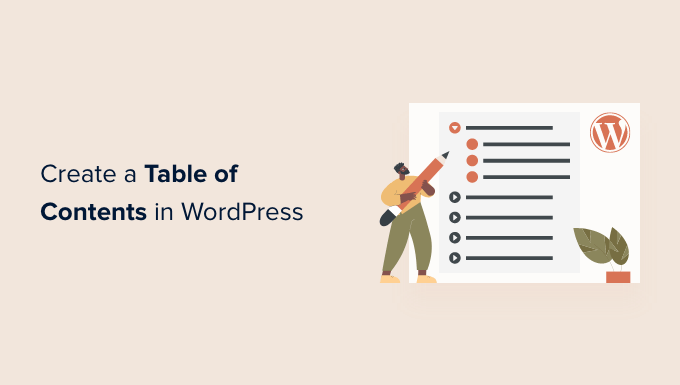
Por que adicionar um índice a posts e páginas no WordPress?
Você pode ter visto o índice em sites como a Wikipedia. Nós também os usamos no WPBeginner para nossos artigos longos, como nosso guia definitivo para aumentar a velocidade e o desempenho do WordPress.
Você pode adicionar um índice às postagens no seu site WordPress para facilitar a navegação entre as seções de um artigo longo.
Eles não apenas melhoram a experiência do usuário, mas também ajudam o SEO do WordPress. Isso porque o Google pode usar o índice para adicionar automaticamente links “pular para a seção” nos resultados de pesquisa.

Um índice também pode ajudar sua publicação a ser listada como um snippet em destaque na parte superior da página de resultados do mecanismo de pesquisa.
Isso o ajudará a obter o máximo de tráfego de SEO.
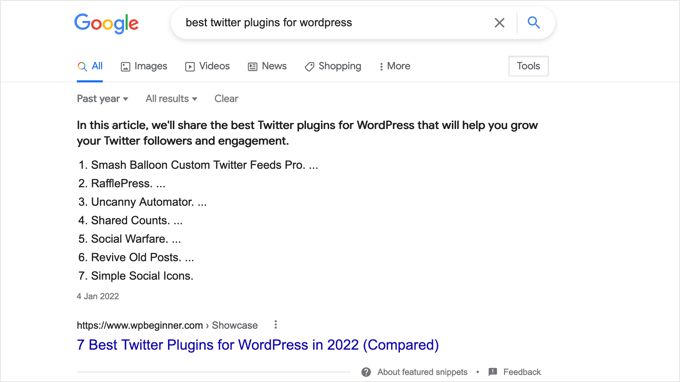
Dito isso, vamos dar uma olhada em como criar um índice fácil em posts e páginas do WordPress. Mostraremos como fazer isso automaticamente com um plug-in e manualmente usando links de âncora:
Método 1: Adicionar um índice automaticamente no WordPress
OAIOSEO, também conhecido como All in One SEO, é o melhor plugin de SEO para WordPress e vem com um bloco de índice integrado para WordPress.
Recomendamos esse método porque ele economiza seu tempo ao gerar automaticamente o índice com base em seus subtítulos, além de torná-lo totalmente personalizável com links editáveis.
Para obter mais informações, consulte nossa análise completa do AIOSEO.
A primeira coisa que você precisa fazer é instalar o plug-in gratuito All in One SEO Lite. Para obter mais detalhes, consulte nosso guia passo a passo sobre como instalar um plug-in do WordPress.
Você só precisa da versão gratuita para adicionar facilmente um índice, mas o AIOSEO Pro oferece ainda mais recursos para ajudá-lo a se classificar melhor nas páginas de resultados dos mecanismos de pesquisa.
Após a ativação, você precisará configurar o plug-in usando o assistente de configuração do AIOSEO. Para obter instruções detalhadas, consulte nosso guia sobre como configurar corretamente o All in One SEO para WordPress.
Como adicionar um índice com o All in One SEO
Você precisará criar ou editar o post ou a página em que deseja adicionar o índice. Depois disso, clique no ícone azul “+” no editor de blocos e localize o bloco “AIOSEO – Table of Contents”.
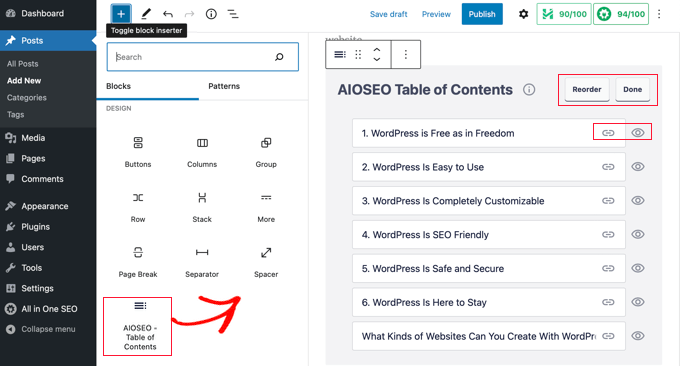
Basta arrastar o bloco para o post ou a página em que você deseja que o índice seja exibido.
Observação: Depois de adicionar um índice, você poderá notar que o bloco “AIOSEO – Table of Contents” ficará acinzentado. Isso ocorre porque você só pode ter um índice por post ou página.
O plug-in identificará automaticamente os títulos da página e os adicionará ao índice. Se você usar diferentes níveis de título (por exemplo, H2 e H3), os títulos de nível inferior serão recuados para mostrar a estrutura do conteúdo.
Se você ainda estiver escrevendo o conteúdo do post ou da página, todos os títulos adicionados ao documento serão automaticamente adicionados ao índice.
Personalização do índice com o All in One SEO
Há algumas maneiras de personalizar o índice de acordo com suas necessidades. Por exemplo, você pode clicar em um título para renomeá-lo. Isso renomeará o título no índice, mas não o artigo.

O AIOSEO criará automaticamente links de âncora para cada título. Você pode clicar no ícone Link para editar o texto âncora, que é alterado tanto no índice quanto no título do conteúdo da postagem.
Você também pode clicar no ícone de olho ao lado de qualquer um dos títulos para ocultá-lo. Os usuários do AIOSEO Pro podem reordenar os títulos no bloco do índice. Ao fazer isso, os títulos serão reorganizados no índice, mas não no artigo.
Você também encontrará uma configuração para o bloco na barra lateral. Aqui, você pode escolher um estilo de lista com marcadores ou numerada para seu índice.
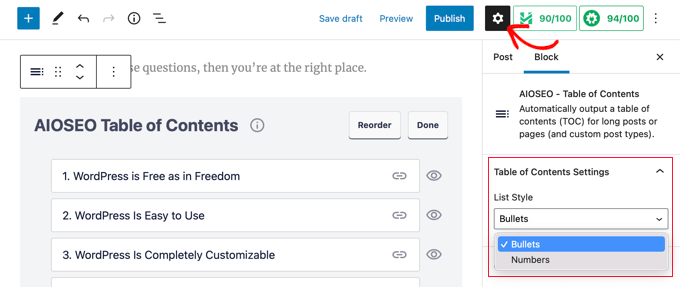
Por fim, quando terminar de personalizar o índice do WordPress, você precisará clicar no botão “Done” (Concluído) para salvar as alterações.
Agora, você poderá ver como o índice será exibido para seus visitantes.
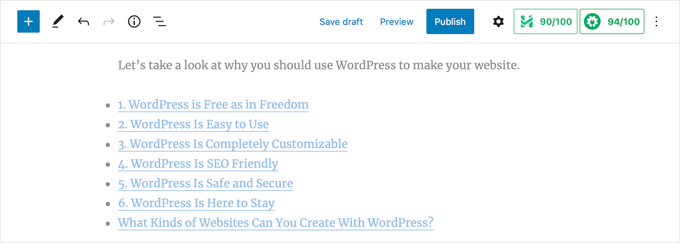
É uma boa ideia adicionar um título ou parágrafo acima do índice. Isso deixará claro para seus leitores que eles estão vendo um índice.
Quando seus visitantes clicarem em um link no índice, eles serão levados imediatamente para esse título do artigo. Isso permite que os usuários acessem a seção na qual estão mais interessados.
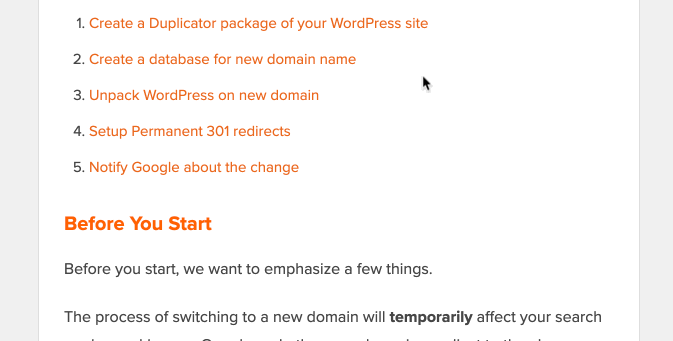
O motivo pelo qual gostamos do recurso de índice do AIOSEO é que ele permite que você personalize os títulos e oculte seletivamente os títulos, conforme necessário.
Esse é um recurso essencial que a maioria dos outros plug-ins de índice simplesmente não tem.
Método 2: Adicionar um índice manualmente no WordPress
Você também pode criar um índice manualmente usando links de âncora sem a necessidade de um plug-in. No entanto, isso exigirá mais tempo e esforço.
Você pode saber mais sobre links de âncora em nosso guia sobre como adicionar links de âncora no WordPress.
Digitação do índice
Primeiro, você precisa adicionar um bloco “List” (Lista) onde poderá adicionar os títulos para o índice. Você pode digitar os títulos na lista ou copiá-los e colá-los um a um do conteúdo do artigo.

Como adicionar texto âncora a blocos de título
Em seguida, você precisará adicionar um atributo de âncora a cada título que deseja referenciar no índice. Isso permitirá que o WordPress saiba para onde ir quando um visitante clicar no título do índice.
Primeiro, você deve clicar no título, como H2 ou H3. Em seguida, você precisa clicar na seta “Advanced” (Avançado) no painel de configurações do bloco para exibir as configurações avançadas.
Depois disso, digite uma palavra ou frase exclusiva sem espaços no campo “HTML anchor” (âncora HTML). Se desejar, você pode usar hífens para separar cada palavra.
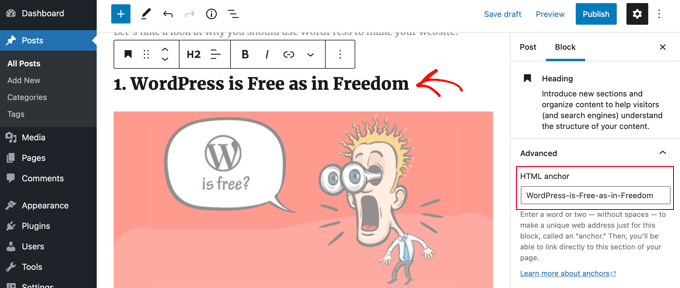
Em seguida, basta repetir esse procedimento para todos os outros títulos que serão incluídos no índice.
Dica: Se você colar o título nesse campo, os hifens serão adicionados automaticamente. Essa é uma maneira fácil de criar uma ID exclusiva que também representa claramente o título.
Adição de links de âncora ao índice
A última etapa é vincular os títulos do índice às âncoras HTML que você criou.
Você deve destacar a primeira entrada do bloco de lista e clicar no ícone “Link” na barra de ferramentas.

Em seguida, você deve digitar uma hashtag (#) e, depois, digitar ou colar o texto âncora para esse título.
O # diz ao WordPress para ir para essa seção da postagem atual. Você não adiciona o nome do domínio ou outros parâmetros de URL.

Feito isso, você precisa pressionar “Enter” ou clicar no ícone “Submit” para criar o link.
O link âncora será adicionado à sua lista de conteúdo. Quando seus visitantes clicarem nesse link, eles serão levados imediatamente para esse título no conteúdo do post ou da página.

Você pode repetir essas etapas para adicionar links de âncora aos outros títulos do índice.
Esperamos que este tutorial tenha ajudado você a aprender como criar um índice em posts e páginas do WordPress. Talvez você também queira ver nosso guia sobre como aumentar o tráfego do seu blog ou nossa seleção de especialistas dos plug-ins obrigatórios do WordPress para expandir seu site.
Se você gostou deste artigo, inscreva-se em nosso canal do YouTube para receber tutoriais em vídeo sobre o WordPress. Você também pode nos encontrar no Twitter e no Facebook.





Syed Balkhi says
Hey WPBeginner readers,
Did you know you can win exciting prizes by commenting on WPBeginner?
Every month, our top blog commenters will win HUGE rewards, including premium WordPress plugin licenses and cash prizes.
You can get more details about the contest from here.
Start sharing your thoughts below to stand a chance to win!
Sam Smith says
I am in word press post editor and I do not see the blue plus button or the advanced block. How do I see those features?
WPBeginner Support says
If you re using the block editor then you may want to try disabling distraction free editing in the top-right and that should allow you to see the plus again.
Administrador
Ahmed Omar says
I am already using the first method, and it help my site to appear first in some search results and of course bringing more visitors
Thank you
WPBeginner Support says
You’re welcome!
Administrador
Thank you so much says
Can you please tell how to change the font color in TOC?
WPBeginner Support says
For that, you would need to use CSS to change the color of the text. You can see how to change the text color in our article below!
https://www.wpbeginner.com/wp-tutorials/how-to-change-the-text-color-in-wordpress-easy-methods/
Administrador
ario says
I tried to create table of content manually like the way you taught us and it worked well, until I added page break and separated the points into different parts or pages. Is there a solution for this?
WPBeginner Support says
If you separate the page then you would need to include the entire URL before the # as well as the anchor to link correctly.
Administrador
Mark says
Back in the day, when websites were new, we used to call this a Site Map. But yeah, it was kind of expected for the search engines to find a site map on your website.
Thanks for the reminder and the info.
WPBeginner Support says
Sitemaps are slightly different, we have our guide below for sitemaps specifically. The Table of contents is to allow your visitors to jump to a specific section of a post
https://www.wpbeginner.com/beginners-guide/what-is-a-wordpress-sitemap-how-to-create-a-sitemap-in-wordpress/
Administrador
samarth says
Which one is better for SEO? Adding TOC manually by HTML or using a Plugin?
WPBeginner Support says
If the information added is the same, then there is no difference. The plugin is there to help make the process easier and help ensure any markup is properly added.
Administrador
Tay says
How can I manually place the TOC on specific pages? It seems I can only disable auto-insertion but I can’t then decide where I want to put the table on the page. Is this possible?
WPBeginner Support says
The table of contents would need to be enabled for pages and then there should be an option when editing the specific page you want to add it to.
Administrador
Muhammad Arslan Sharif says
What a tutorial and very helpful for me and other who want to add new features in their websites and in blogs. In very short words you explain exceptionally.
WPBeginner Support says
Glad you found our guide helpful
Administrador
Rianne says
Brilliant! What I thought would take me hours took me 20 minutes instead
WPBeginner Support says
Glad our guide was helpful
Administrador
Claudia says
Thank you for all your helpful articles!
WPBeginner Support says
You’re welcome
Administrador
Kim Balchios says
My developer created a Table of Contents on a really long blog I wrote. I edited one of the entries and the link fell off.
When I try to create a new entry it says “Paste URL or type to search.” If I add the URL, it will take the reader to the top of the blog not the exact place inside the blog.
WPBeginner Support says
You would want to create an anchor link following our guide below:
https://www.wpbeginner.com/beginners-guide/how-to-easily-add-anchor-links-in-wordpress-step-by-step/
Administrador
David Ellin says
this video shows me how to create a table of contents within a post. I want to create a table of contents for my entire blog so that the title of each article appears in the TOC. How do I do that?
WPBeginner Support says
You would want to take a look at our article below for how to create a blog page as a ToC would get far too long for what you’re wanting to do.
https://www.wpbeginner.com/wp-tutorials/how-to-create-a-separate-page-for-blog-posts-in-wordpress/
Administrador
jean says
Hi thank you for this informative post!
Only a small question, what is “override the global settings for this specific post / page.”
I chose to insert the table of content manually, and when i check only for h2 & h3, the table of content just doesn’t show up at all.
Thank you!
WPBeginner Support says
That would mean you are telling it to ignore your default settings for the plugin for that specific post/page. If you have no H2 or H3s on the page then there wouldn’t be anything for the plugin to add to the table.
Administrador
Ahmad Zeeshan says
In setting there is no “Table of Content”. Where to find it?
WPBeginner Support says
You would want to ensure you activated the plugin after installing it.
Administrador
Dheeraj soni says
Thanks for sharing an informative article, your content always helps me to go next level.
WPBeginner Support says
You’re welcome, glad you found our content helpful
Administrador
Asthen says
Why wpbeginner don’t recommend using TOC unless it’s really long ?
How long is too long ?
WPBeginner Support says
If the page is too short to scroll then there wouldn’t be a reason to have a table of contents. It is a personal preference for the length of a post.
Administrador
SAHIL DHIMAAN says
Hi, very helpful article
But….
Table of content isn’t showing in Mobile, what to do…
i use AMP plugin also…
WPBeginner Support says
Your AMP plugin would be removing the plugin’s additions. If you reach out to the table of contents plugin’s support they can let you know if they have AMP support.
Administrador
Bee Lian Low says
Thank you, I have waited so long before I decided to install this Table Of ontent!
WPBeginner Support says
You’re welcome
Administrador
Cecilia says
Thanks. Easy to use.
WPBeginner Support says
You’re welcome
Administrador
Lucimar says
Good afternoon!
Congratulations on the article, it helped me a lot
However, it just didn’t work on amp pages.
Note: I use the “Accelerated Mobile Pages” plugin.
How can I solve?
Thank you!
WPBeginner Support says
You would want to reach out to the plugin’s support for if there is a recommendation for AMP.
Administrador
Džangir Kolar says
Hi!
How those this plugin affect the speed of the page itself?
WPBeginner Support says
It shouldn’t affect your page’s speed.
Administrador
Luke Richardson says
Using easy table of contents, is there an option to create hyperlinks to jump to that particular section when you click on one of the headings in the table.
Not sure if I’m missing something with the plugin, but when I click on the headings it doesn’t jump to that section at all.
thanks
WPBeginner Support says
The plugin should be allowing that, you may want to ensure there is enough room between your content and you don’t have any browser addons that would prevent scrolling to a certain section of your page.
Administrador
Tosh Lubek says
I’ve checked “Initially hide the table of contents” but the TOC shows every time I open a post with a TOC. Is there something else I need to do?
WPBeginner Support says
You would want to reach out to the plugin’s support to ensure this is not a conflict between the plugin and your theme
Administrador
Oulimata says
As usual, amazingly detailed and helpful. You guys have definitely become my go-to resource for anything blogging related.
WPBeginner Support says
Thank you, glad we can continue to be helpful
Administrador
Raaz shrestha says
The plugin is really great. Thanks for sharing wpbeginner team.
WPBeginner Support says
Glad you liked our recommendation
Administrador
Akamps says
Hey is there a way i can put this table of contents in my sidebar
WPBeginner Support says
The plugin does have a widget you can use
Administrador
Nic says
Is there anyway to centre the table?
WPBeginner Support says
You would need to enable custom CSS and depending on your theme would determine the CSS needed
Administrador
KM says
How use the plugin “manually” just one lost at a time? Instructions not clear
WPBeginner Support says
You would enable support for the post type you want to have the table of contents in and when you edit one of the types where it is activated, it will have the option at the bottom of the editor to add the table of contents
Administrador
Kelvin says
NO it’s POSTS again – not pages!
How do I get a table into a page?
WPBeginner Support says
In the plugin’s settings you would enable support for pages and you should be able to follow the same procedure for pages that you do for posts.
Administrador
Rishi says
nice
WPBeginner Support says
Glad you like our article
Administrador
Abhishek says
Hi, is this possible to show/hide individual headings, just by clicking on it, like on Wikipedia?
I have too many subheadings under each h3 so I want it to be easier to navigate.
WPBeginner Support says
Hi Abhishek,
Please see our article on how to show hide text in WordPress using toggle effect.
Administrador
Alex says
Thanks for article!
Prince Gabriel Okocha says
I have installed this plugin on my blog following the guideline in this post. But it’s not showing up on my posts. Is there anything I’m doing wrong? I really need this to ASAP
WPBeginner Support says
Hello,
Please review plugin settings, you need to enable support for the posts and pages. After that edit the post and page and below the post editor you will find TOC settings. From here, you need to check the box ‘Insert table of contents’ to add it in that particular post.
Administrador
Srinu says
Thanks for the article it’s working for me, But I am getting with bullets and numbers, in TOC_Box how to change it. I already numbered with h2 tags.
so its repeated the numbers twice.
Mae says
Thank you so much! I used this for my Exclusives Library and I love it! Now my subscribers won’t have a difficult time looking for their printables.
XOXO,
Mae
Jan Peter Aursnes says
A fine plugin, but is there any way I can exclude pages? Writing in headings and using * and ⎮ does not work, for me anyway. I am not a tech guy so it could be I just need a bit of explanation.
Thanks in advance.
Raushan says
This is best plugin but when i created table of content from this plugin then showing multiple H1 tag which is not good at seo point of view.
How to solve this ?
Thanks
Sunil Suresh says
Thanks. Your article came at the right time for me! I was just now looking for something like this for a client of mine.